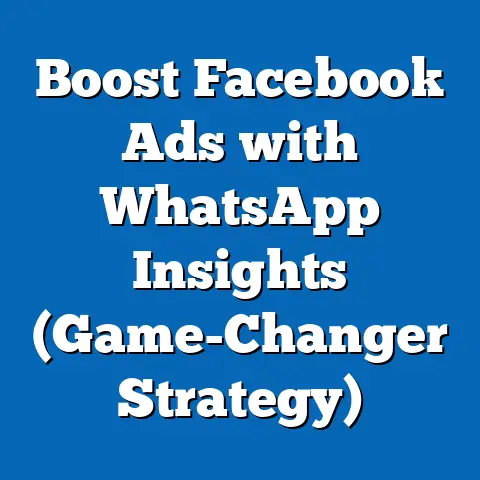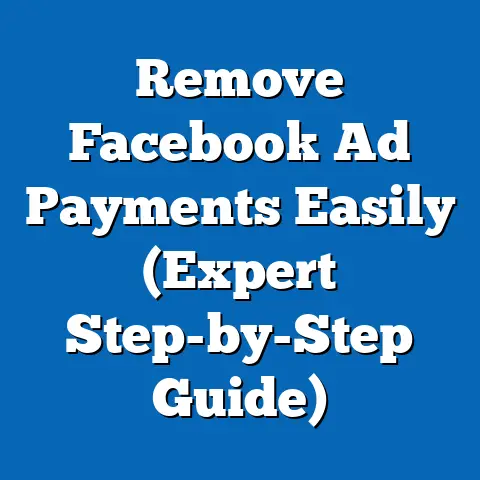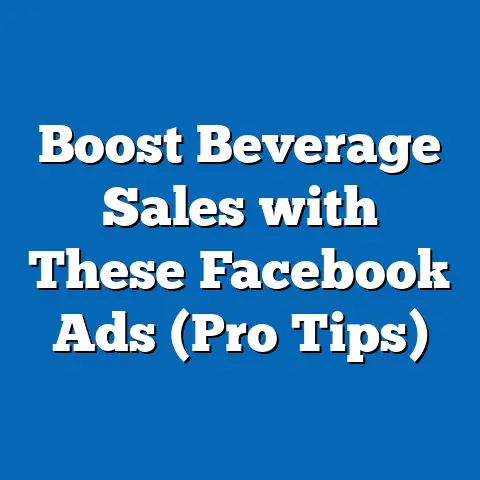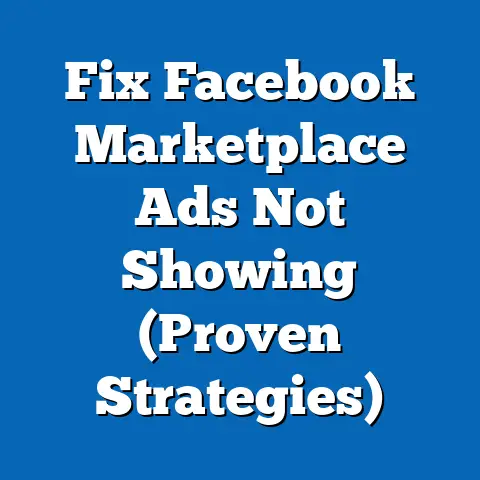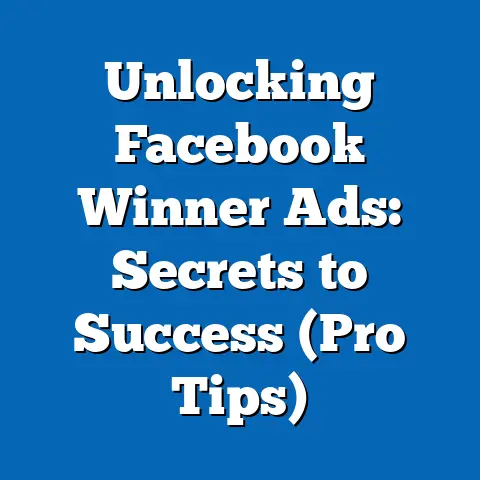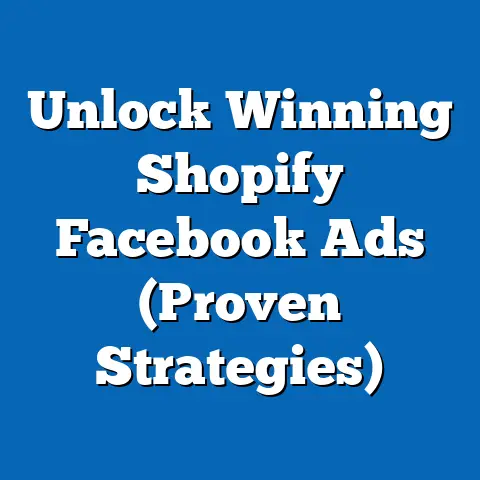Boost Facebook Ad Reach Today (Essential Strategies)
Have you ever felt like your Facebook ads are shouting into a void? You craft the perfect message, design stunning visuals, and meticulously target your audience, only to see your reach stagnate. It’s a frustrating experience, and believe me, I’ve been there. I remember launching a campaign for a local bakery, thinking it was a guaranteed success, only to be met with a dishearteningly small reach. It was a wake-up call that taught me the importance of a strategic approach to Facebook advertising.
Facebook Ads, at its core, is a phenomenal tool. It offers businesses of all sizes the ability to connect with a vast and diverse audience, targeting individuals based on demographics, interests, behaviors, and more. It’s like having a laser-focused megaphone, allowing you to amplify your message to those most likely to be interested in what you have to offer. But just having the megaphone isn’t enough. You need to know how to use it effectively.
In today’s hyper-competitive digital landscape, simply creating an ad and hoping for the best is a recipe for wasted ad spend and missed opportunities. Maximizing your ad reach is crucial for brand visibility, driving traffic, generating leads, and ultimately, boosting sales. But how do you cut through the noise and ensure your ads are seen by the right people?
Understanding Facebook Ad Reach
So, what exactly is ad reach? It’s a fundamental metric in Facebook advertising, but it’s often misunderstood. Simply put, ad reach refers to the total number of unique individuals who have seen your ad. It’s not about how many times your ad was displayed (that’s impressions), but rather how many different people saw it at least once.
Think of it like this: If your ad was shown 1,000 times (1,000 impressions) but only reached 500 unique people, your reach is 500. Each of those 500 people might have seen the ad multiple times, contributing to the total impressions.
Reach vs. Impressions vs. Engagement
It’s important to differentiate reach from other key metrics like impressions and engagement:
- Impressions: The number of times your ad was displayed, regardless of whether it was seen by the same person multiple times.
- Reach: The number of unique individuals who saw your ad.
- Engagement: The number of interactions your ad received, such as likes, comments, shares, and clicks.
While all three metrics are valuable, reach is particularly important for brand visibility and customer acquisition. A high reach means you’re exposing your brand to a larger audience, increasing brand awareness and potentially attracting new customers.
The Significance of Ad Reach
Ad reach is the foundation upon which successful Facebook ad campaigns are built. It’s the first step in the marketing funnel, the initial exposure that can lead to further engagement and, ultimately, conversions.
Here’s why ad reach is so significant:
- Brand Visibility: A wider reach means more people are familiar with your brand. This is crucial for building brand recognition and establishing trust.
- Customer Acquisition: Reaching new potential customers is essential for business growth. Ad reach allows you to tap into new markets and expand your customer base.
- Website Traffic: By driving traffic to your website through your ads, you can increase engagement and conversions.
- Lead Generation: A broad reach can help you attract more leads, filling your sales funnel with potential customers.
- Improved Ad Relevance: A higher reach can also improve your ad relevance score, leading to lower ad costs and better performance.
Navigating Facebook Ads Manager for Reach Metrics
Facebook Ads Manager is your command center for all things advertising. It’s where you create, manage, and analyze your ad campaigns. To understand your ad reach, you need to know where to find the relevant metrics within Ads Manager.
Here’s a quick guide:
- Access Ads Manager: Log in to your Facebook account and navigate to Ads Manager.
- Select Your Campaign: Choose the campaign you want to analyze.
- View Results: In the results column, you’ll see the “Reach” metric. This is the number of unique people who saw your ad.
- Customize Columns: You can customize the columns to display other relevant metrics, such as impressions, engagement, and cost per reach.
Takeaway: Understanding ad reach and how it differs from impressions and engagement is crucial for building successful Facebook ad campaigns. Regularly monitor your reach metrics in Ads Manager to assess the effectiveness of your strategies.
Setting Clear Objectives
Before diving into the tactical aspects of boosting your Facebook ad reach, it’s crucial to establish clear objectives. Why are you running these ads in the first place? What do you hope to achieve? Without a clear understanding of your goals, you’ll be shooting in the dark, wasting valuable time and resources.
I’ve seen countless businesses launch Facebook ad campaigns with vague objectives like “increase brand awareness” or “get more customers.” While these are valid aspirations, they lack the specificity needed to guide your strategy and measure your success.
The Importance of Specific, Measurable Objectives
The key to setting effective objectives is to make them SMART:
- Specific: Clearly define what you want to achieve.
- Measurable: Establish metrics to track your progress.
- Achievable: Set realistic goals that are within your reach.
- Relevant: Ensure your objectives align with your overall business goals.
- Time-bound: Set a deadline for achieving your objectives.
For example, instead of “increase brand awareness,” a SMART objective might be “increase brand awareness among women aged 25-34 in the United States by 20% in the next three months, as measured by a brand lift study on Facebook.”
Common Facebook Ad Objectives and Their Relationship to Reach
Facebook Ads Manager offers a variety of campaign objectives, each designed to achieve specific goals. Here’s how some of the most common objectives relate to reach:
- Brand Awareness: This objective focuses on maximizing reach to increase brand recognition. It’s ideal for introducing your brand to a new audience or reinforcing your brand message.
- Reach: This objective is specifically designed to show your ad to the maximum number of people within your target audience. It’s a good choice for campaigns where broad exposure is the primary goal.
- Traffic: This objective aims to drive traffic to your website or landing page. While reach is important, the focus is on attracting qualified visitors who are likely to convert.
- Engagement: This objective encourages interactions with your ad, such as likes, comments, shares, and event responses. Reach is still relevant, but the emphasis is on generating active engagement.
- Leads: This objective aims to collect leads through lead forms or other methods. Reach is important for attracting potential leads, but the focus is on capturing contact information for follow-up.
- Conversions: This objective focuses on driving specific actions, such as purchases, sign-ups, or downloads. Reach is important for attracting potential customers, but the emphasis is on driving conversions.
How Objectives Influence Targeting and Content Strategy
Your chosen objective will significantly influence your targeting and content strategy. For example, if your objective is brand awareness, you might focus on broad targeting and visually appealing content that captures attention. On the other hand, if your objective is conversions, you might focus on narrow targeting and persuasive content that highlights the benefits of your product or service.
Let’s look at a few scenarios:
-
Scenario 1: Launching a New Product
- Objective: Brand Awareness and Traffic
- Targeting: Broad demographic and interest-based targeting to reach a large audience.
- Content Strategy: Visually appealing ads showcasing the product’s features and benefits, with a clear call-to-action to visit the website.
-
Scenario 2: Promoting a Limited-Time Offer
-
Objective: Conversions
- Targeting: Retargeting website visitors and existing customers with personalized ads.
- Content Strategy: Urgency-driven ads highlighting the limited-time offer and a clear call-to-action to purchase.
-
Scenario 3: Building an Email List
-
Objective: Leads
- Targeting: Interest-based targeting and Lookalike Audiences to reach potential subscribers.
- Content Strategy: Value-driven ads offering a free ebook or exclusive content in exchange for email sign-up.
Scenario 1: Launching a New Product
- Objective: Brand Awareness and Traffic
- Targeting: Broad demographic and interest-based targeting to reach a large audience.
- Content Strategy: Visually appealing ads showcasing the product’s features and benefits, with a clear call-to-action to visit the website.
-
Scenario 2: Promoting a Limited-Time Offer
-
Objective: Conversions
- Targeting: Retargeting website visitors and existing customers with personalized ads.
- Content Strategy: Urgency-driven ads highlighting the limited-time offer and a clear call-to-action to purchase.
-
Scenario 3: Building an Email List
-
Objective: Leads
- Targeting: Interest-based targeting and Lookalike Audiences to reach potential subscribers.
- Content Strategy: Value-driven ads offering a free ebook or exclusive content in exchange for email sign-up.
Scenario 2: Promoting a Limited-Time Offer
Objective: Conversions
Scenario 3: Building an Email List
Objective: Leads
Leveraging the Facebook Ads Objective Selection Tool
Facebook Ads Manager offers a helpful tool to guide you in selecting the right objective for your campaign. When creating a new campaign, you’ll be presented with a list of objectives categorized into three main areas: Awareness, Consideration, and Conversion.
- Awareness: Brand Awareness and Reach
- Consideration: Traffic, Engagement, App Installs, Video Views, Lead Generation, Messages
- Conversion: Conversions, Catalog Sales, Store Traffic
Each objective comes with a brief description and guidance on when to use it. Take the time to carefully consider your goals and choose the objective that best aligns with your desired outcome.
Takeaway: Setting clear, measurable objectives is essential for successful Facebook ad campaigns. Choose the right objective based on your goals and tailor your targeting and content strategy accordingly. Use the Facebook Ads Objective Selection tool to guide your decision-making process.
Audience Targeting Strategies
Once you have a clear understanding of your objectives, the next crucial step is to define your target audience. Who are you trying to reach with your ads? The more precisely you can identify your ideal customer, the more effective your ad campaigns will be.
I’ve seen firsthand the transformative power of effective audience targeting. I worked with a local bookstore that was struggling to attract new customers. By meticulously defining their target audience based on demographics, interests, and behaviors, we were able to significantly increase their ad reach and drive more foot traffic to their store.
Demographic Targeting
Demographic targeting allows you to reach people based on their age, gender, location, education, job title, and other demographic characteristics. This is a fundamental targeting option that can be used to narrow down your audience and ensure your ads are seen by the right people.
- Age: Target specific age groups that are most likely to be interested in your product or service.
- Gender: Target men, women, or both, depending on your target audience.
- Location: Target specific countries, regions, cities, or even zip codes.
- Education: Target people based on their education level, such as high school, college, or graduate school.
- Job Title: Target people based on their job title or industry.
Interest-Based Targeting
Interest-based targeting allows you to reach people based on their interests, hobbies, and the pages they’ve liked on Facebook. This is a powerful targeting option that can help you connect with people who are passionate about your niche.
- Interests: Target people based on their interests, such as sports, music, movies, or books.
- Hobbies: Target people based on their hobbies, such as gardening, cooking, or photography.
- Pages Liked: Target people who have liked specific pages related to your industry or niche.
Behavioral Targeting
Behavioral targeting allows you to reach people based on their purchase behavior, device usage, travel habits, and other behavioral characteristics. This is a highly effective targeting option that can help you connect with people who are most likely to convert.
- Purchase Behavior: Target people who have made purchases in specific categories, such as clothing, electronics, or home goods.
- Device Usage: Target people based on the type of device they use, such as smartphones, tablets, or desktops.
- Travel Habits: Target people who travel frequently or have specific travel interests.
Custom Audiences and Lookalike Audiences
Custom Audiences and Lookalike Audiences are advanced targeting options that allow you to leverage your existing customer data and reach new potential customers.
- Custom Audiences: Create custom audiences based on your existing customer data, such as email lists, website visitors, or app users. This allows you to retarget people who have already interacted with your brand.
- Lookalike Audiences: Create lookalike audiences based on your custom audiences. This allows you to reach new people who share similar characteristics with your existing customers.
Creating and Refining Audience Segments in Ads Manager
Facebook Ads Manager provides a user-friendly interface for creating and refining audience segments. Here’s a step-by-step guide:
- Access Ads Manager: Log in to your Facebook account and navigate to Ads Manager.
- Create a New Campaign: Click on the “Create” button to start a new campaign.
- Choose Your Objective: Select the objective that best aligns with your goals.
- Define Your Audience: In the “Audience” section, you can define your target audience based on demographics, interests, behaviors, custom audiences, and lookalike audiences.
- Refine Your Audience: Use the “Narrow Audience” option to further refine your targeting by adding additional criteria.
- Exclude Audiences: Use the “Exclude” option to exclude specific audiences from your targeting.
- Save Your Audience: Save your audience for future use.
A/B Testing Audience Segments
A/B testing is a crucial step in optimizing your audience targeting strategy. It involves creating multiple ad sets with different audience segments and comparing their performance to identify which segment drives the best reach and engagement.
Here’s how to A/B test audience segments:
- Create Multiple Ad Sets: Create multiple ad sets within the same campaign, each targeting a different audience segment.
- Use the Same Ad Creative: Use the same ad creative for all ad sets to ensure a fair comparison.
- Set a Budget: Allocate a budget to each ad set.
- Monitor Performance: Monitor the performance of each ad set, paying attention to reach, engagement, and conversion rates.
- Analyze Results: Analyze the results to identify which audience segment performs best.
- Optimize Your Targeting: Focus your budget on the best-performing audience segment and refine your targeting accordingly.
Takeaway: Effective audience targeting is crucial for maximizing your Facebook ad reach. Leverage demographic, interest-based, behavioral, custom, and lookalike audiences to connect with the right people. A/B test different audience segments to optimize your targeting strategy and drive better results.
Crafting Compelling Ad Content
Reaching the right audience is only half the battle. Once you’ve identified your target demographic, you need to create compelling ad content that captures their attention and encourages them to take action. Think of your ad as a tiny billboard vying for attention in a sea of competing messages.
I’ve learned that crafting effective ad content is an art and a science. It requires a deep understanding of your target audience, a creative flair, and a data-driven approach to optimization. I once worked with a client who insisted on using the same generic ad copy for every campaign. After convincing them to invest in creating tailored content for each audience segment, we saw a dramatic increase in engagement and conversions.
The Elements of Effective Ad Content
Effective ad content typically includes the following elements:
- High-Quality Visuals: Images and videos are the first thing people see, so make sure they’re visually appealing and relevant to your message.
- Compelling Copy: Your ad copy should be clear, concise, and persuasive. Highlight the benefits of your product or service and address the needs and pain points of your target audience.
- Eye-Catching Headlines: Your headline should grab attention and entice people to learn more. Use strong verbs and keywords to make your headline stand out.
- Persuasive Calls-to-Action (CTAs): Your CTA should tell people what you want them to do next. Use clear and concise language, such as “Shop Now,” “Learn More,” or “Sign Up.”
The Importance of High-Quality Visuals
Visuals are the cornerstone of effective Facebook ads. They’re the first thing people see, and they play a crucial role in capturing attention and conveying your message.
Here are some tips for creating high-quality visuals:
- Use High-Resolution Images: Avoid blurry or pixelated images.
- Choose Relevant Images: Make sure your images are relevant to your product or service and your target audience.
- Use Eye-Catching Colors: Use colors that are visually appealing and stand out from the Facebook news feed.
- Incorporate Branding: Incorporate your brand logo and colors into your visuals.
- Use Videos: Videos are highly engaging and can be a great way to tell your brand story.
Tips for Writing Compelling Ad Copy
Your ad copy should be clear, concise, and persuasive. It should highlight the benefits of your product or service and address the needs and pain points of your target audience.
Here are some tips for writing compelling ad copy:
Here are some tips for crafting eye-catching headlines:
- Use Strong Verbs: Use strong verbs to make your headline more engaging.
- Use Numbers: Numbers can make your headline more credible and attention-grabbing.
- Ask a Question: Asking a question can pique people’s curiosity and encourage them to click.
- Highlight a Benefit: Highlight a key benefit of your product or service.
- Create Curiosity: Create curiosity by hinting at something intriguing or unexpected.
The Power of Persuasive Calls-to-Action (CTAs)
Your CTA tells people what you want them to do next. It should be clear, concise, and persuasive.
Here are some tips for crafting persuasive CTAs:
- Use Clear and Concise Language: Tell people exactly what you want them to do.
- Use Strong Verbs: Use strong verbs to make your CTA more compelling.
- Create a Sense of Urgency: Use language that creates a sense of urgency.
- Make it Visually Appealing: Make your CTA button visually appealing and easy to click.
- Test Different CTAs: A/B test different CTAs to see which one performs best.
The Role of Storytelling in Ads
Storytelling is a powerful tool for connecting with your audience on an emotional level. By telling a compelling story, you can capture their attention, build trust, and create a lasting impression.
Here are some tips for incorporating storytelling into your ads:
- Focus on the Customer: Tell stories about your customers and how your product or service has helped them.
- Create a Narrative: Develop a narrative that engages the audience and keeps them interested.
- Use Emotion: Use emotion to connect with your audience on a deeper level.
- Be Authentic: Be authentic and genuine in your storytelling.
Examples of Successful Facebook Ads with Strong Content Strategies
Let’s look at a few examples of successful Facebook ads that exemplify strong content strategies:
-
Example 1: Dollar Shave Club
- Visuals: Humorous and engaging video that showcases the product and its benefits.
- Copy: Witty and relatable copy that speaks to the target audience.
- Headline: “Shave Time. Shave Money.”
- CTA: “Get Started”
-
Example 2: Airbnb
-
Visuals: Stunning photos of unique and desirable vacation rentals.
- Copy: Descriptive and evocative copy that paints a picture of the travel experience.
- Headline: “Discover Unforgettable Getaways”
- CTA: “Explore Now”
-
Example 3: Warby Parker
-
Visuals: Stylish photos of people wearing Warby Parker glasses.
- Copy: Simple and clear copy that highlights the brand’s affordability and convenience.
- Headline: “Find Your Perfect Pair”
- CTA: “Shop Now”
Example 1: Dollar Shave Club
- Visuals: Humorous and engaging video that showcases the product and its benefits.
- Copy: Witty and relatable copy that speaks to the target audience.
- Headline: “Shave Time. Shave Money.”
- CTA: “Get Started”
-
Example 2: Airbnb
-
Visuals: Stunning photos of unique and desirable vacation rentals.
- Copy: Descriptive and evocative copy that paints a picture of the travel experience.
- Headline: “Discover Unforgettable Getaways”
- CTA: “Explore Now”
-
Example 3: Warby Parker
-
Visuals: Stylish photos of people wearing Warby Parker glasses.
- Copy: Simple and clear copy that highlights the brand’s affordability and convenience.
- Headline: “Find Your Perfect Pair”
- CTA: “Shop Now”
Example 2: Airbnb
Visuals: Stunning photos of unique and desirable vacation rentals.
Example 3: Warby Parker
Visuals: Stylish photos of people wearing Warby Parker glasses.
Takeaway: Compelling ad content is essential for capturing attention and driving engagement. Focus on creating high-quality visuals, writing persuasive copy, crafting eye-catching headlines, using persuasive CTAs, and incorporating storytelling into your ads. Analyze successful Facebook ads to learn from their strategies and apply them to your own campaigns.
Leveraging Facebook Ad Formats
Facebook offers a diverse range of ad formats, each designed to cater to different objectives and content strategies. Understanding the nuances of each format and knowing when to use them is crucial for maximizing your ad reach and engagement. It’s like having a toolbox filled with different tools – knowing which tool to use for which task is essential for getting the job done right.
I’ve found that experimenting with different ad formats can be a game-changer. I once worked with a fashion retailer who was only using image ads. By introducing video ads and carousel ads, we were able to showcase their products in a more engaging way and significantly increase their ad reach and conversions.
Types of Facebook Ad Formats
Here’s an overview of the most popular Facebook ad formats:
- Image Ads: Single image ads are the simplest and most common ad format. They’re great for showcasing a product, service, or brand message.
- Video Ads: Video ads are highly engaging and can be a great way to tell your brand story, demonstrate a product, or share a testimonial.
- Carousel Ads: Carousel ads allow you to showcase multiple images or videos in a single ad. They’re great for showcasing a range of products, highlighting different features, or telling a story.
- Slideshow Ads: Slideshow ads are a cost-effective way to create video-like ads using a series of images. They’re great for showcasing a product or service in a visually appealing way.
- Collection Ads: Collection ads are designed for mobile shoppers and allow you to showcase a catalog of products in an immersive and visually appealing way.
Unique Advantages of Each Format
Each ad format offers unique advantages:
- Image Ads: Simple, cost-effective, and easy to create.
- Video Ads: Highly engaging, great for storytelling, and can generate high reach.
- Carousel Ads: Showcase multiple products, highlight different features, and tell a story.
- Slideshow Ads: Cost-effective, visually appealing, and can generate high reach.
- Collection Ads: Immersive shopping experience, great for mobile users, and drives product discovery.
When to Use Different Ad Formats
Here’s a guide on when to use different ad formats based on your campaign objectives:
- Brand Awareness: Video Ads, Slideshow Ads
- Reach: Video Ads, Slideshow Ads
- Traffic: Image Ads, Carousel Ads
- Engagement: Video Ads, Carousel Ads
- Leads: Image Ads, Carousel Ads
- Conversions: Carousel Ads, Collection Ads
Tips for Optimizing Ad Formats
Here are some tips for optimizing ad formats to enhance reach and engagement:
- Use High-Quality Visuals: Use high-resolution images and videos that are visually appealing and relevant to your message.
- Optimize for Mobile: Ensure your ads are optimized for mobile devices, as most Facebook users access the platform on their smartphones.
- Use Captions: Add captions to your videos, as many people watch videos with the sound off.
- Test Different Formats: A/B test different ad formats to see which one performs best for your target audience and campaign objectives.
- Use Clear CTAs: Use clear and concise calls-to-action that tell people what you want them to do next.
Takeaway: Facebook offers a diverse range of ad formats, each with its own unique advantages. Understand the nuances of each format and choose the one that best aligns with your campaign objectives. Optimize your ad formats by using high-quality visuals, optimizing for mobile, using captions, testing different formats, and using clear CTAs.
Budgeting and Bidding Strategies
Budgeting and bidding are two critical components of Facebook advertising that directly impact your ad reach and overall campaign performance. It’s like fueling a car – if you don’t have enough fuel (budget) or you’re not driving efficiently (bidding strategy), you won’t get very far.
I’ve learned that finding the right balance between budget and bidding is an ongoing process. I once worked with a startup that was hesitant to invest in Facebook advertising. By starting with a small budget and gradually increasing it as we saw positive results, we were able to build their confidence and demonstrate the value of Facebook advertising.
How Budgeting Affects Ad Reach
Your budget determines how many people your ads can reach. A larger budget allows you to show your ads to more people, increasing your overall reach. However, it’s important to remember that a larger budget doesn’t guarantee success. You also need to have effective targeting, compelling ad content, and optimized bidding strategies.
Facebook offers two main types of budgets:
- Daily Budget: Sets a daily average amount that you’re willing to spend on your ads.
- Lifetime Budget: Sets a total amount that you’re willing to spend on your ads over the entire duration of the campaign.
The choice between daily and lifetime budgets depends on your campaign goals and how much control you want over your spending.
- Daily Budget: Use a daily budget if you want to run your ads continuously and have a consistent daily spend.
- Lifetime Budget: Use a lifetime budget if you want to run your ads for a specific period and have a fixed total spend.
Bidding Strategies: Automatic vs. Manual Bidding
Bidding strategies determine how Facebook bids on ad placements on your behalf. Facebook offers two main types of bidding strategies:
- Automatic Bidding: Facebook automatically sets your bids to get the most results for your budget.
- Manual Bidding: You set your bids manually, giving you more control over your spending.
The choice between automatic and manual bidding depends on your experience level and how much control you want over your bids.
- Automatic Bidding: Use automatic bidding if you’re new to Facebook advertising or want to simplify the bidding process.
- Manual Bidding: Use manual bidding if you have experience with Facebook advertising and want to have more control over your bids.
Optimizing Budget Allocation
Optimizing budget allocation involves distributing your budget across different campaigns and audience segments to maximize your overall results.
Here are some tips for optimizing budget allocation:
- Prioritize High-Performing Campaigns: Allocate more budget to campaigns that are performing well.
- Test Different Audience Segments: A/B test different audience segments to see which ones are most responsive.
- Use Budget Pacing: Use budget pacing to control how quickly your budget is spent.
- Monitor Performance Regularly: Monitor your campaign performance regularly and adjust your budget allocation as needed.
Ad Scheduling and Timing
Ad scheduling allows you to schedule your ads to run at specific times of day or days of the week. This can be a valuable tool for optimizing your ad reach and targeting your audience when they’re most likely to be online and engaged.
For example, if you’re targeting working professionals, you might schedule your ads to run during lunch breaks or after work hours.
Takeaway: Budgeting and bidding are crucial components of Facebook advertising that directly impact your ad reach and campaign performance. Understand the different budget types and bidding strategies, optimize your budget allocation, and use ad scheduling to target your audience when they’re most likely to be online.
Analyzing and Optimizing Performance
Launching your Facebook ad campaign is just the beginning. The real magic happens when you start analyzing the data and optimizing your campaigns for better results. It’s like conducting a scientific experiment – you need to gather data, analyze the results, and adjust your approach based on what you learn.
I’ve learned that continuous monitoring and optimization are essential for long-term success. I once worked with a client who launched a successful Facebook ad campaign but then neglected to monitor its performance. Over time, the campaign’s performance declined, and they eventually stopped running ads altogether.
The Importance of Regular Monitoring
Regular monitoring allows you to identify trends, spot problems, and make informed decisions about how to improve your campaign performance.
Here are some key metrics to track:
- Reach: The number of unique people who saw your ad.
- Impressions: The number of times your ad was displayed.
- Engagement: The number of interactions your ad received, such as likes, comments, shares, and clicks.
- Click-Through Rate (CTR): The percentage of people who saw your ad and clicked on it.
- Conversion Rate: The percentage of people who clicked on your ad and completed a desired action, such as making a purchase or signing up for an email list.
- Cost Per Click (CPC): The amount you pay each time someone clicks on your ad.
- Cost Per Conversion (CPC): The amount you pay each time someone completes a desired action.
Key Metrics to Track
Let’s delve deeper into some of these key metrics and their significance:
- Reach: As we’ve discussed, reach is the foundation. A declining reach can indicate issues with your targeting or ad relevance.
- Click-Through Rate (CTR): A low CTR suggests that your ad content isn’t resonating with your audience. Experiment with different visuals, headlines, and copy to improve your CTR.
- Conversion Rate: A low conversion rate indicates that people are clicking on your ad but not completing the desired action on your website or landing page. This could be due to issues with your website design, pricing, or product offering.
- Cost Per Click (CPC): A high CPC indicates that you’re paying too much for each click. This could be due to competition, low ad relevance, or poor targeting.
- Cost Per Conversion (CPC): A high CPC indicates that you’re paying too much for each conversion. This could be due to issues with your website design, pricing, or product offering.
Using Facebook Analytics for Deeper Insights
Facebook Analytics provides a wealth of data about your website visitors, app users, and Facebook page fans. This data can be used to gain deeper insights into your audience, understand their behavior, and optimize your marketing efforts.
Here are some ways to use Facebook Analytics:
- Track Website Traffic: Track the number of visitors to your website, their demographics, and their behavior on your site.
- Track App Usage: Track the number of users of your app, their demographics, and their behavior within the app.
- Track Facebook Page Engagement: Track the number of fans of your Facebook page, their demographics, and their engagement with your content.
- Create Custom Reports: Create custom reports to track the metrics that are most important to your business.
Interpreting Data and Making Informed Decisions
The key to successful optimization is to interpret your data correctly and make informed decisions based on what you learn.
Here are some tips for interpreting data:
- Look for Trends: Look for trends in your data over time. Are your metrics improving, declining, or staying the same?
- Compare Different Segments: Compare the performance of different audience segments. Which segments are performing best?
- Identify Problems: Identify any problems that are affecting your campaign performance. Are your CTRs low? Are your conversion rates low?
- Test Different Solutions: Test different solutions to address any problems you identify. Try different ad creatives, targeting options, or bidding strategies.
Optimizing Ongoing Ad Campaigns
Optimizing your ad campaigns is an ongoing process. You should regularly monitor your performance, analyze your data, and make adjustments as needed.
Here are some tips for optimizing your ad campaigns:
- A/B Test Ad Creatives: A/B test different ad creatives to see which ones perform best.
- Refine Your Targeting: Refine your targeting to reach the people who are most likely to convert.
- Adjust Your Bidding Strategies: Adjust your bidding strategies to optimize your spending.
- Monitor Performance Regularly: Monitor your campaign performance regularly and make adjustments as needed.
Takeaway: Analyzing and optimizing your Facebook ad campaigns is essential for achieving long-term success. Regularly monitor your performance, analyze your data, and make informed decisions based on what you learn. Use Facebook Analytics to gain deeper insights into your audience and optimize your marketing efforts.
Remember, Facebook advertising is not a “set it and forget it” endeavor. It requires continuous learning, experimentation, and adaptation. The platform is constantly evolving, with new features, targeting options, and algorithms being introduced regularly. Stay up-to-date with the latest trends and best practices to maintain a competitive edge.
The significance of maximizing Facebook ad reach cannot be overstated. In today’s crowded digital landscape, it’s crucial to break through the noise and connect with your target audience. A wider reach means increased brand visibility, greater customer acquisition, more website traffic, more leads, and ultimately, more sales.
Now, it’s time to put these strategies into practice. Don’t be afraid to experiment with different approaches, track your results, and learn from your mistakes. The more you experiment, the more you’ll discover what works best for your specific business and target audience.
I encourage you to implement the strategies outlined in this guide and experiment with your Facebook ad campaigns for improved reach. Start with a small budget, test different ad creatives and targeting options, and gradually scale up your efforts as you see positive results.
Remember, success in Facebook advertising is a journey, not a destination. Embrace the process, stay persistent, and never stop learning. With the right strategies and a commitment to continuous improvement, you can unlock the full potential of Facebook ads and achieve your business goals. So, go forth and conquer the Facebook advertising landscape!

